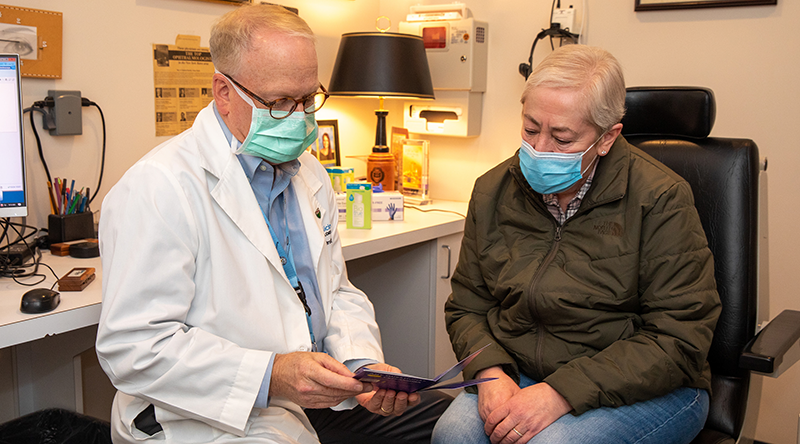
Brian DeBroff, MD, chief of Ophthalmology at Bridgeport Hospital, reviews a new prescription option for dry eye syndrome with Kim Colicci of Trumbull.
Don’t get blindsided by dry eye syndrome
You’ve likely seen the commercials and you may have experienced the symptoms yourself: The gritty, itching, burning, achy symptoms of dry eye syndrome are real, and so is the battle. Just ask Kim Colicci, who has been dealing with eye issues and related dry eye symptoms for years.
“It actually wakes me up a few times a night because it’s painful, and I have to put drops in my eyes,” said Colicci, a Trumbull resident, who says she has tried virtually every over-the-counter product available as well as one prescription drug. “I don’t ever get a full night’s sleep.”
Recently, Colicci sought relief – and a new plan of attack for her chronic dry eye – when she went to see Brian DeBroff, MD, chief of Ophthalmology at Bridgeport Hospital and director of cataract and intraocular implant surgery for Yale Medicine Ophthalmology.
“Dry eye is a very common disorder that can be debilitating,” said Dr. DeBroff, who sees patients at 495 Hawley Lane in Stratford. “For people over 50, it affects anywhere from 10 to 30 percent of the population, which is a very large percentage.”
What causes dry eye?
A host of things can cause dry eye, including diseases such as hypertension and diabetes; immune disorders, such as rheumatoid arthritis and lupus; and medications such as antihistamines, beta-blockers, diuretics, anti-Parkinson’s drugs and chemotherapy.
“Dry eye can also be seasonal,” Dr. DeBroff said. “During the winter when the heat is on, the humidity levels are much lower and the air is much drier. If people have very dry heat in their house and don’t have a humidifier, oftentimes, their eyes can dry out quite quickly.”
And for some – like Colicci, a retired federal corrections employee – working in front of a computer screen (or using other electronic devices) for long periods of time can also contribute to the symptoms.
Treating dry eye
To effectively treat dry eye, the first step is an eye exam to identify the cause of dryness. There are two main types of dry eye: One is called aqueous tear-deficiency, in which tears are not sufficiently produced to lubricate the eyes; the more common form is an evaporative type in which tears are produced but evaporate too quickly.
To address the symptoms in his practice, Vicente Diaz, MD, director of Ophthalmology for the Connecticut Burn Center at Bridgeport Hospital, uses a stepwise approach.
“If you are producing tears but they are evaporating too quickly, I would recommend warm compresses and Omega-3 fatty acid supplements,” Dr. Diaz said. “If you are not producing enough tears, you start with artificial tears that provide lubrication.”
“I usually start with an over-the-counter product,” Dr. Diaz noted. “If the artificial tears are being used on the order of three to four times a day and the patient is still symptomatic, then at that point, we think about something prescription strength. And then if that doesn’t work, there are other things further in the algorithm we can consider.”
Punctal plugs are one option; these tiny devices are placed in the tear ducts to block the drainage canal, so that the tears stay around the eye.
In more severe cases, amniotic membranes harvested from placenta tissue after a baby’s birth is a newer option. “Disk-shaped grafts are placed on the eye to ‘wake up’ the glands around the eye that are not working; suddenly, the glands start working and secreting lubrication again,” Dr. Diaz explained. “This would certainly not be first-line treatment, but it can be offered in cases where other methods haven’t provided relief.”
Future looks bright
“Most of the time, we can control dry eye syndrome with medications,” Dr. DeBroff said, noting that less than 1 percent require surgery. “The nice thing is we are seeing a number of different investigative drops that are currently in Phase 2 and Phase 3 trials so, hopefully, in the next year or two we’ll have even more treatment options to offer our patients.”
Learn more about Ophthalmology services at Bridgeport Hospital.

